| Listing 1 - 10 of 36 | << page >> |
Sort by
|
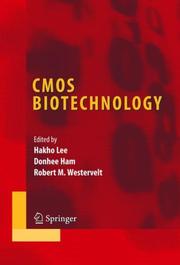
ISBN: 1280865369 9786610865369 0387689133 0387368361 Year: 2007 Publisher: New York : Springer,
Abstract | Keywords | Export | Availability | Bookmark
 Loading...
Loading...Choose an application
- Reference Manager
- EndNote
- RefWorks (Direct export to RefWorks)
CMOS Biotechnology reviews the recent research and developments joining CMOS technology with biology. Written by leading researchers these chapters delve into four areas including: Microfluidics for electrical engineers CMOS Actuators CMOS Electrical Sensors CMOS Optical Sensors Bioanalytical instruments have been miniaturized on ICs to study various biophenomena or to actuate biosystems. These bio-lab-on-IC systems utilize the IC to facilitate faster, repeatable, and standardized biological experiments at low cost with a small volume of biological sample. CMOS Biotechnology will interest electrical engineers, bioengineers, biophysicists as well as researchers in MEMS, bioMEMS, microelectronics, microfluidics, and circuits and systems.
Metal oxide semiconductors, Complementary. --- Biochips. --- Bioreactors --- Molecular computers --- Combinatorial chemistry --- CMOS (Electronics) --- Complementary metal oxide semiconductors --- Semiconductors, Complementary metal oxide --- Digital electronics --- Logic circuits --- Transistor-transistor logic circuits
Book
ISBN: 0081020627 0081020619 9780081020623 9780081020616 Year: 2018 Publisher: Cambridge, Massachusetts : Elsevier,
Abstract | Keywords | Export | Availability | Bookmark
 Loading...
Loading...Choose an application
- Reference Manager
- EndNote
- RefWorks (Direct export to RefWorks)
Book
ISBN: 0081021402 0081021399 9780081021408 9780081021392 Year: 2018 Publisher: Duxford, United Kingdom : Woodhead Publishing, An imprint of Elsevier,
Abstract | Keywords | Export | Availability | Bookmark
 Loading...
Loading...Choose an application
- Reference Manager
- EndNote
- RefWorks (Direct export to RefWorks)
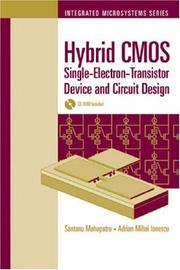
ISBN: 1596930705 9781596930704 9781596930698 1596930691 Year: 2006 Publisher: Boston, MA ; London : Artech House,
Abstract | Keywords | Export | Availability | Bookmark
 Loading...
Loading...Choose an application
- Reference Manager
- EndNote
- RefWorks (Direct export to RefWorks)
"Take advantage of the low-power consumption and enhanced functionality of SETs (single electron transistors) along with the high-speed driving and voltage gain of CMSO technology. This cutting-edge resource provides you with the conceptual framework for CMSO-SET hybrid circuit design. Supported with over 180 illustrations and packaged with a CD-ROM of practical supplementary material, the book explains spice simulation of SETs and co-simulation with CMOS, introduces specific design strategies for hybrid CMOS-SET circuits, and presents CMOS-SET co-fabrication techniques. You gain a thorough understanding of the pros and cons of digital SETs, learn how SETs can help to solve the intrinsic drawbacks of CMOS technology, and discover how the hybridization of both technologies can produce new analog functionalities which are difficult to achieve in a pure CMOS approach. From the basic physics of single electron transistors and SET modeling, to advanced concepts like CMSO-SET co-integration, the book helps you realize significant performance benefits by showing you how to incorporate SET technology into your design projects."--Publisher's website.
Metal oxide semiconductors, Complementary. --- Integrated circuits --- CMOS (Electronics) --- Complementary metal oxide semiconductors --- Semiconductors, Complementary metal oxide --- Digital electronics --- Logic circuits --- Transistor-transistor logic circuits --- Design and construction.
Book
ISBN: 1608071545 9781608071548 1608071537 9781608071531 Year: 2013 Publisher: Boston : [Piscataqay, New Jersey] : Artech House, IEEE Xplore,
Abstract | Keywords | Export | Availability | Bookmark
 Loading...
Loading...Choose an application
- Reference Manager
- EndNote
- RefWorks (Direct export to RefWorks)
This cutting-edge volume provides an analytical method for designing CMOS Op Amp circuits, placing emphasis on the practical aspects of the design process. It takes an in-depth look at CMOS differential amplifiers, explaining how they are the main part of all Op Amps. It presents important details and a design method for the different architectures of single ended Op Amps. There are complete chapters dedicated to the critical issues of CMOS output stages, fully differential Op Amps, and CMOS reference generators. This resource also includes an introduction to CMOS technology and the basics of the physical aspects of MOS transistors, providing the foundation needed to fully master the material. --
Metal oxide semiconductors, Complementary. --- Operational amplifiers. --- CMOS (Electronics) --- Complementary metal oxide semiconductors --- Semiconductors, Complementary metal oxide --- Digital electronics --- Logic circuits --- Transistor-transistor logic circuits --- Amplifiers (Electronics)
Book
ISBN: 9781617615450 1617615455 9781617613258 1617613258 Year: 2011 Publisher: New York : Nova Science Publishers,
Abstract | Keywords | Export | Availability | Bookmark
 Loading...
Loading...Choose an application
- Reference Manager
- EndNote
- RefWorks (Direct export to RefWorks)
Book
ISBN: 9781400862849 1400862841 0691087636 9780691603018 9780691087634 0691087636 0691603014 9780691603018 0691632456 9780691632452 Year: 1992 Publisher: Princeton, New Jersey : Princeton University Press,
Abstract | Keywords | Export | Availability | Bookmark
 Loading...
Loading...Choose an application
- Reference Manager
- EndNote
- RefWorks (Direct export to RefWorks)
CMOS chips are becoming increasingly important in computer circuitry. They have been widely used during the past decade, and they will continue to grow in popularity in those application areas that demand high performance. Challenging the prevailing opinion that circuit simulation can reveal all problems in CMOS circuits, Masakazu Shoji maintains that simulation cannot completely remove the often costly errors that occur in circuit design. To address the failure modes of these circuits more fully, he presents a new approach to CMOS circuit design based on his systematizing of circuit design error and his unique theory of CMOS digital circuit operation. In analyzing CMOS digital circuits, the author focuses not on effects originating from the characteristics of the device (MOSFET) but on those arising from their connection. This emphasis allows him to formulate a powerful but ultimately simple theory explaining the effects of connectivity by using a concept of the states of the circuits, called microstates. Shoji introduces microstate sequence diagrams that describe the state changes (or the circuit connectivity changes), and he uses his microstate theory to analyze many of the conventional CMOS digital circuits. These analyses are practically all in closed-form, and they provide easy physical interpretation of the circuit's working mechanisms, the parametric dependence of performance, and the circuit's failure modes.Originally published in 1992.The Princeton Legacy Library uses the latest print-on-demand technology to again make available previously out-of-print books from the distinguished backlist of Princeton University Press. These editions preserve the original texts of these important books while presenting them in durable paperback and hardcover editions. The goal of the Princeton Legacy Library is to vastly increase access to the rich scholarly heritage found in the thousands of books published by Princeton University Press since its founding in 1905.
Metal oxide semiconductors, Complementary. --- Semiconductors --- Digital integrated circuits --- Failures in semiconductors --- System failures (Engineering) --- CMOS (Electronics) --- Complementary metal oxide semiconductors --- Semiconductors, Complementary metal oxide --- Digital electronics --- Logic circuits --- Transistor-transistor logic circuits --- Failures. --- Design and construction --- Data processing.
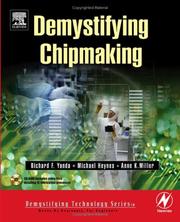
ISBN: 1281009792 9786611009793 0080477097 0750677600 1423723503 9781423723509 9780750677608 9780080477091 Year: 2005 Publisher: Oxford : Amsterdam : Newnes ; Elsevier,
Abstract | Keywords | Export | Availability | Bookmark
 Loading...
Loading...Choose an application
- Reference Manager
- EndNote
- RefWorks (Direct export to RefWorks)
This book takes the reader through the actual manufacturing process of making a typical chip, from start to finish, including a detailed discussion of each step, in plain language. The evolution of today's technology is added to the story, as seen through the eyes of the engineers who solved some of the problems. The authors are well suited to that discussion since they are three of those same engineers. They have a broad exposure to the industry and its technology that extends all the way back to Shockley Laboratories, the first semiconductor manufacturer in Silicon Valley.The CMOS (C
Logic circuits. --- Logic circuits --- Metal oxide semiconductors, Complementary --- Electrical & Computer Engineering --- Engineering & Applied Sciences --- Electrical Engineering --- Design and construction --- Metal oxide semiconductors, Complementary. --- Design and construction. --- CMOS (Electronics) --- Complementary metal oxide semiconductors --- Semiconductors, Complementary metal oxide --- Circuits, Logic --- Digital electronics --- Transistor-transistor logic circuits --- Computers --- Electronic circuits --- Interface circuits --- Switching circuits --- Switching theory --- Circuits
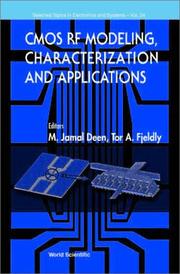
ISBN: 9812777768 9789812777768 9789810249052 9789812777768 9810249055 Year: 2002 Volume: 24 Publisher: River Edge, N.J. : World Scientific,
Abstract | Keywords | Export | Availability | Bookmark
 Loading...
Loading...Choose an application
- Reference Manager
- EndNote
- RefWorks (Direct export to RefWorks)
CMOS technology has now reached a state of evolution, in terms of both frequency and noise, where it is becoming a serious contender for radio frequency (RF) applications in the GHz range. Cutoff frequencies of about 50 GHz have been reported for 0.18 µm CMOS technology, and are expected to reach about 100 GHz when the feature size shrinks to 100 nm within a few years. This translates into CMOS circuit operating frequencies well into the GHz range, which covers the frequency range of many of today's popular wireless products, such as cell phones, GPS (global positioning system) and Bluetooth. Of course, the great interest in RF CMOS comes from the obvious advantages of CMOS technology in terms of production cost, high-level integration, and the ability to combine digital, analog and RF circuits on the same chip. This book discusses many of the challenges facing the CMOS RF circuit designer in terms of device modeling and characterization, which are crucial issues in circuit simulation and design.
Metal oxide semiconductors, Complementary. --- Semiconductors. --- Crystalline semiconductors --- Semi-conductors --- Semiconducting materials --- Semiconductor devices --- Crystals --- Electrical engineering --- Electronics --- Solid state electronics --- CMOS (Electronics) --- Complementary metal oxide semiconductors --- Semiconductors, Complementary metal oxide --- Digital electronics --- Logic circuits --- Transistor-transistor logic circuits --- Materials --- Metal oxide semiconductors, Complementary --- Very high speed integrated circuits
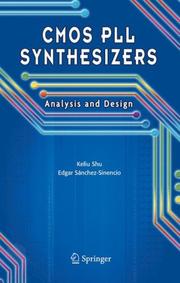
ISBN: 1280147830 9786610147830 0387236694 0387236686 1441936505 Year: 2005 Publisher: New York ; [Great Britain] : Springer,
Abstract | Keywords | Export | Availability | Bookmark
 Loading...
Loading...Choose an application
- Reference Manager
- EndNote
- RefWorks (Direct export to RefWorks)
CMOS PLL Synthesizers: Analysis and Design presents both fundamentals and state of the art PLL synthesizer design and analysis techniques. A complete overview of both system-level and circuit-level design and analysis are covered. A 16mW, 2.4GHz, sub-2V, S D fractional-N synthesizer prototype is implemented in 0.35mm CMOS. It features a high-speed and robust phase-switching prescaler, and a low-complexity and area-efficient loop capacitance mulitplier, which elegantly tackle speed and integration bottlenecks of PLL synthesizer. This book is useful as a PLL synthesizer manual for both academic researchers and industry design engineers.
Metal oxide semiconductors, Complementary. --- Phase-locked loops. --- Voltage-controlled oscillators --- Wireless communication systems. --- Design and construction. --- VCOs (Voltage-controlled oscillators) --- Oscillators, Electric --- Loops, Phase-locked --- Demodulation (Electronics) --- Telecommunication --- CMOS (Electronics) --- Complementary metal oxide semiconductors --- Semiconductors, Complementary metal oxide --- Digital electronics --- Logic circuits --- Transistor-transistor logic circuits --- Communication systems, Wireless --- Wireless data communication systems --- Wireless information networks --- Wireless telecommunication systems --- Telecommunication systems --- Computer engineering. --- Electrical Engineering. --- Computers --- Design and construction
| Listing 1 - 10 of 36 | << page >> |
Sort by
|

 Search
Search Feedback
Feedback About UniCat
About UniCat  Help
Help News
News